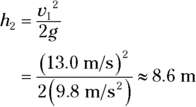Chapter 9
Getting Some Work Out of Physics
In This Chapter
 Working through forces
Working through forces
 Evaluating kinetic and potential energy
Evaluating kinetic and potential energy
 Walking the path of conservative and nonconservative forces
Walking the path of conservative and nonconservative forces
 Accounting for mechanical energy and power in work
Accounting for mechanical energy and power in work
You know all about work; it’s what you do when you have to do physics problems. You sit down with your calculator, you sweat a little, and you get through it. You’ve done your work. Unfortunately, that doesn’t count as work in physics terms.
In physics, work is done when a force moves an object through a displacement. That may not be your boss’s idea of work, but it gets the job done in physics. Along with the basics of work, we use this chapter to introduce kinetic and potential energy, look at conservative and nonconservative forces, and examine mechanical energy and power.
Looking for Work
Holding heavy objects — like, say, a set of exercise weights — up in the air seems to take a lot of work. In physics terms, however, that isn’t true. Even though holding up weights may take a lot of biological work, no mechanical work takes place if the weights aren’t moving.
Remember: In physics, mechanical work is performed on an object when a force moves the object through a displacement. When the force is constant and the angle between the force and the displacement is  , then the work done is given by
, then the work done is given by  . In layman’s terms, if you push a 1,000-pound hockey puck for some distance, physics says that the work you do is the component of the force you apply in the direction of travel multiplied by the distance you go.
. In layman’s terms, if you push a 1,000-pound hockey puck for some distance, physics says that the work you do is the component of the force you apply in the direction of travel multiplied by the distance you go.
To get a picture of the full work spectrum, you need to look across different systems of measurement. After you have the measurement units down, you can look at practical working examples, such as pushing and dragging. You can also figure out what negative work means.
Working on measurement systems
Work is a scalar, not a vector; therefore, it has only a magnitude, not a direction (more on scalars and vectors in Chapter 4). Because work is force times distance,  , it has the unit newton-meter (N · m or N-m) in the MKS system (see Chapter 2 for info on systems of measurement).
, it has the unit newton-meter (N · m or N-m) in the MKS system (see Chapter 2 for info on systems of measurement).
Remember: Mechanical work done by a net force is equivalent to a transfer of energy (this is called the work-energy theorem), which has units called joules. Because of this, work and energy have the same units. For conversion purposes, 1 newton of force applied through a distance of 1 meter (where the force is applied along the line of the displacement) is equivalent to 1 joule, or 1 J, of work. (In the foot-pound-second system, work has the unit foot-pound. You can also discuss energy and work in terms of kilowatt-hours, which you may be familiar with from electric bills; 1 kilowatt-hour [kWh]  joules.)
joules.)
Working with force
Motion is a requirement of work. For work to be done, a net force has to move an object through a displacement. Work is a product of force and displacement.
The angle between the force and the displacement affects how much work gets done. If you apply force at an angle instead of parallel to the direction of motion, you have to supply more force to perform the same amount of work. If the force moving the object has a component in the same direction as the motion, the work that force does on the object is positive. If the force moving the object has a component in the opposite direction of the motion, the work done by that force on the object is negative. Here are some examples and practice questions for you to work through.
Examples
Q. Say that you’re pushing a huge gold ingot 3 kilometers to your home, as the following figure shows. Suppose that the kinetic coefficient of friction (see Chapter 6),  , between the ingot and the ground is 0.250 and that the ingot has a mass of 1,000.0 kilograms. How much work do you have to do to get it home?
, between the ingot and the ground is 0.250 and that the ingot has a mass of 1,000.0 kilograms. How much work do you have to do to get it home?
A. The correct answer is  .
.
- Start with this equation for the force of friction:
- Because the road is flat, the magnitude of the normal force, FN, is just mg (mass times the acceleration due to gravity on the surface of the Earth). That means that
- Plug in the numbers:
- Use the formula for work:
- Because you’re pushing the ingot with a force that’s parallel to the ground, the angle between Fpush and s is 0°, and cos 0° = 1. You do the least amount of work if you push the ingot at a constant velocity, which means that Fpush = FF .
- Plug in the numbers:
Q. You find another huge gold ingot 3.0 kilometers from your home. This time you decide to drag it along with rope that’s at an angle of 10° from the ground, as the following figure shows. Suppose that the kinetic coefficient of friction (see Chapter 6),  , between the ingot and the ground is 0.250 and that the ingot has a mass of 1,000.0 kilograms. How much work do you have to do to get it home?
, between the ingot and the ground is 0.250 and that the ingot has a mass of 1,000.0 kilograms. How much work do you have to do to get it home?
A. The correct answer is  .
.
- The normal force with the ground is given by the weight of the ingot minus the upward component of the force you supply. Therefore, the force of friction is given by
- The horizontal component of your force equals the force of friction:
- Plug in the frictional force:
- Solve for Fpull, and plug in the numbers:
- Use the equation for work:
Q. You and your friends try to lift the huge gold ingot to take it inside your home. You manage to lift the gold ingot 25 centimeters, before realizing that it’s too heavy. You then very slowly set the ingot down. If the ingot has a mass of 1,000.0 kilograms, how much work did you do setting the ingot down?
A. The correct answer is  .
.
- The force you exerted on the ingot is equal to the weight of the ingot, or 9,800 newtons.
-
Use the equation for work:
You did negative work, because the force and the displacement were in opposite directions.
Practice Questions
1. You’re pulling a chest of drawers, applying a force of 60.0 newtons at an angle of 60.0°. How much work do you do pulling it over 10.0 meters?
2. You’re dragging a sled on a rope at 30°, applying a force of 20.0 newtons. How much work do you do over 1.0 kilometers?
3. You’re pushing a box of dishes across the kitchen floor, using 100.0 joules to move it 10.0 meters. If you apply the force at 60.0°, what is the force you used?
4. You’re pushing an out-of-gas car down the road, applying a force of 800.0 newtons. How much work have you done in moving the car 10.0 meters?
5. A construction foreman exerts 1,300 newtons of force trying to move a 1,200-kilogram block of concrete. How many joules of work does the foreman perform?
Practice Answers
1. 300 J. Use the equation W = Fs cos θ.
Plug in the numbers:
2. 1.7 × 104 J. Use the equation W = Fs cos θ.
Plug in the numbers:
3. 20 N. Use the equation W = Fs cos θ.
Solve for force:
Plug in the numbers:
4. 8,000 J. Use the equation W = Fs cos θ.
Plug in the numbers:
5. 0 J. Although the foreman exerted a force, the concrete didn’t move, which means that no distance was traversed. Because work is the product of force and distance, if the distance is 0, then the work done must also be 0.
Making a Move: Kinetic Energy
Remember: When you start pushing or pulling a stationary object with a constant force, it starts to move if the force you exert is greater than the net forces resisting the movement, such as friction and gravity. If the object starts to move at some speed, it will acquire kinetic energy. Kinetic energy is the energy an object has because of its motion. Energy is the ability to do work.
You know the ins and outs of kinetic energy. So how do you calculate it?
The work-energy theorem: Turning work into kinetic energy
A force acting on an object that undergoes a displacement does work on the object. If this force is a net force that accelerates the object (according to Newton’s second law — see Chapter 5), then the velocity changes due to the acceleration (see Chapter 3). The change in velocity means that there is a change in the kinetic energy of the object.
Remember: The change in kinetic energy of the object is equal to the work done by the net force acting on it. This is a very important principle called the work-energy theorem.
After you know how work relates to kinetic energy, you’re ready to take a look at how kinetic energy relates to the speed and mass of the object.
The equation to find kinetic energy, KE, is as follows, where m is mass and v is velocity:
Using a little math, you can show that work required to accelerate the object from rest is also equal to  . Say, for example, that you apply a force to a model airplane to get it flying and that the plane is accelerating. Here’s the equation for net force:
. Say, for example, that you apply a force to a model airplane to get it flying and that the plane is accelerating. Here’s the equation for net force:
The work done on the plane, which becomes its kinetic energy, equals the following:
Net force, F, equals mass times acceleration. Assume that you’re pushing in the same direction that the plane is going; in this case,  , so
, so
You can tie this equation to the final and original velocity of the object. Use the equation  (see Chapter 3), where vf equals final velocity and vi equals initial velocity. Solving for a gives you
(see Chapter 3), where vf equals final velocity and vi equals initial velocity. Solving for a gives you
If you plug this value of a into the equation for work,  , you get the following:
, you get the following:
If the initial velocity is 0, you get
This is the work that you put into accelerating the model plane — that is, into the plane’s motion — and that work becomes the plane’s kinetic energy, KE:
This is just the work-energy theorem stated as an equation.
Using the kinetic energy equation
You normally use the kinetic energy equation to find the kinetic energy of an object when you know its mass and velocity. The equation to find kinetic energy is
That’s the energy of motion.
Example
Q. Say that you push a spaceship, mass 1,000.0 kilograms, by applying a force of 1.00 × 104 newtons for 1.00 meters. How fast does the spaceship end up traveling?
A. The correct answer is 4.47 meters per second.
- Find the total work done:
- The work done on the spaceship goes into its kinetic energy, and its initial kinetic energy is 0, so its final kinetic energy is 1.0 × 104 joules.
-
Use the equation for kinetic energy and solve for v:
The final speed is 4.47 meters per second.
Practice Questions
1. You’re applying 600.0 newtons of force to a car with a mass of 1,000.0 kilograms. You’re traveling a distance of 100.0 meters on a frictionless, icy road. What is the car’s final speed?
2. You’re applying 3,000.0 newtons of force to a hockey puck with a mass of 0.10 kilograms. It travels over a distance of 0.10 meters on a frictionless ice rink. What is the puck’s final speed?
Practice Answers
1. 11 m/s. Find the total work done:
The work done on the car goes into its kinetic energy, so its final kinetic energy is 6.0 × 104 joules.
Use the equation for kinetic energy and solve for v:
Plug in the numbers:
 m2/s2
m2/s2
The final speed = 1201/2 m/s = 11 m/s.
2. 77 m/s. Find the total work done:
The work done on the puck goes into its kinetic energy, so its final kinetic energy is 300 joules.
Use the equation for kinetic energy and solve for v:
Plug in the numbers:
 m2/s2
m2/s2
The final speed = 6,0001/2 = 77 m/s.
Calculating changes in kinetic energy by using net force
In everyday life, multiple forces act on an object, and you have to take them into account. If you want to find the change in an object’s kinetic energy, you have to consider only the work done by the net force. In other words, you convert only the work done by the net force into kinetic energy.
Example
Q. In the following figure, a 1,000.0-kilogram safe full of gold bars is sliding down a 3.0-meter ramp that meets the horizontal at an angle of 23°. The coefficient of kinetic friction is 0.15. What will the safe’s speed be when it reaches the bottom of the ramp?
A. The correct answer is 3.8 meters per second.
- Determine the net force acting on the safe. The component of the safe’s weight acting along the ramp is
- You know that the normal force is
That means that the kinetic force of friction is
- The net force accelerating the safe down the ramp, Fnet, is
- Plug in the numbers:
- The net force, 2,450 newtons, acts over the entire 3.0-meter ramp, so the work done by this force is
- The 7,350 joules of work done on the safe by the net force goes into the safe’s kinetic energy. You find the safe’s kinetic energy by using this equation:
- Solve for v2:
Practice Questions
1. An 80.0-kilogram person trips and slides down a 20.0-meter toboggan run of 27°. If the coefficient of kinetic friction is 0.10, what is the person’s speed at the bottom of the run?
2. You’re going down a 100.0-meter ski jump at an angle of 40.0°. Your mass (including skis!) is 90.0 kilograms, and the coefficient of kinetic friction is 0.050. What is your speed at the bottom of the jump?
Practice Answers
1. 11.8 m/s. Find the net force on the sliding person. The component of the person’s weight acting along the run is
The normal force on the person is
which means that the kinetic force of friction is
The net force accelerating the person down the ramp, Fnet, is
Plug in the numbers:
The net force acts over the 20.0-meter toboggan ramp, so the work done by this force is
The 5,600 joules of work done on the person goes into the person’s kinetic energy. Find the person’s kinetic energy:
Solve:
2. 35 m/s. Find the net force on yourself to start. The component of your weight acting along the ski jump is
The normal force on yourself is
which means the kinetic force of friction is
The net force accelerating you down the ski jump, Fnet, is
Plug in the numbers:
This net force acts over the 100-meter jump, so the work done by this force is
That work goes into your kinetic energy:
Solve:
Energy in the Bank: Potential Energy
There’s more to motion than kinetic energy — an object can also have potential energy, which is stored energy or the energy an object has because of its position. The energy is called potential because it can be converted to kinetic energy or other forms of energy, such as thermal energy.
Objects can have potential energy from different sources. To give an object potential energy, all you need to do is perform work on an object against a force, such as when you pull back on an object connected to a spring. Gravity is a very common source of potential energy in physics problems.
Suppose that you have the job of taking your little cousin Jackie to the park, and you put the little tyke on the slide. Jackie starts at rest and then accelerates, ending up with quite a bit of speed at the bottom of the slide. You sense physics at work here. Taking out your clipboard, you put Jackie higher up the slide and let go, watching carefully. Sure enough, Jackie ends up going even faster at the bottom of the slide. You decide to move Jackie even higher up. (Suddenly, Jackie’s mother shows up and grabs him from you. That’s enough physics for one day.)
What was happening on the slide? Where did Jackie’s kinetic energy come from? It ultimately came from the work you did lifting Jackie against the force of gravity. Jackie sits at rest at the bottom of the slide, so he has no kinetic energy. If you lift him to the top of the slide and hold him, he waits for the next trip down the slide, so he has no motion and no kinetic energy. However, you did work lifting him up against the force of gravity, so he has potential energy. As Jackie slides down the (frictionless) slide, gravity turns your work — and Jackie’s potential energy — into kinetic energy.
To new heights: Gravitational potential energy
How much work do you do when you lift an object against the force of gravity? Suppose that you want to store a cannonball on an upper shelf at height h above where the cannonball is now. The work you do is
In this case, F equals the force required to overcome gravity, s equals distance, and  is the angle between them. The gravitational force on an object is mg (mass times the acceleration due to gravity, 9.8 meters per second2), and when you lift the cannonball straight up,
is the angle between them. The gravitational force on an object is mg (mass times the acceleration due to gravity, 9.8 meters per second2), and when you lift the cannonball straight up,  , so
, so
The variable h here is the distance you lift the cannonball. To lift the ball, you have to do a certain amount of work, or m times g times h. The cannonball is stationary when you put it on the shelf, so it has no kinetic energy. However, it does have potential energy, which is the work you put into the ball to lift it to its present position.
If the cannonball rolls to the edge of the shelf and falls off, how much kinetic energy would it have just before it strikes the ground (which is where it started when you first lifted it)? It would have mgh joules of kinetic energy at that point. The ball’s potential energy, which came from the work you put in lifting it, changes to kinetic energy thanks to the fall.
Remember: In general, you can say that if you have an object of mass m near the surface of the Earth (where the acceleration due to gravity is g), at a height h, then the potential energy of that mass compared to what it’d be at height 0 (where  at some reference height) is
at some reference height) is
And if you move an object vertically against the force of gravity from height hi to height hf , its change in potential energy is
The work you perform on the object changes its potential energy.
Example
Q. During a basketball game, a 1.0-kilogram ball gets thrown vertically in the air. It’s momentarily stationary at a height of 5.0 meters above the floor and then falls back down. What is the ball’s speed when it hits the floor?
A. The correct answer is 9.9 meters per second.
- Find out how much potential energy the ball has when it starts to fall. Use this equation for potential energy:
- This potential energy will be converted into kinetic energy, so you expand the equation like so:
- Solve for v2:
- Solve for v:
- Plug in the numbers:
Practice Questions
1. You jump out of an airplane at 2,000 feet and fall 1,000 feet before opening your parachute. What is your speed in feet per second (neglecting air resistance) when you open your chute?
2. If you’re in an airplane at 30,000.0 feet, what is your potential energy if you have a mass of 70.0 kilograms?
Practice Answers
1. 254 ft/s. Figure out how much potential energy you have when you start to fall. That potential energy is
Find out how much potential energy is converted into kinetic energy when you open your parachute. The change in potential energy, ΔPE, is
This potential energy will be converted into kinetic energy, so you have
Note that in the FPI system of units, g = 32.2 ft/s2.
Solve:
2. 6.3 × 106 J. The equation for potential energy is
Convert 30,000 feet into meters, using the fact that 1 foot = 0.305 meters:
Plug in the numbers:
Choose Your Path: Conservative versus Nonconservative Forces
The work a conservative force does on an object is path-independent; the actual path taken by the object makes no difference. Fifty meters up in the air has the same gravitational potential energy whether you get there by taking the steps or by hopping on a Ferris wheel. That’s different from the force of friction, which dissipates kinetic energy as heat. When friction is involved, the path you take does matter — a longer path will dissipate more kinetic energy than a short one. For that reason, friction is a nonconservative force.
For example, suppose that you and some buddies arrive at Mt. Newton, a majestic peak that rises h meters into the air. You can take two ways up — the quick way or the scenic route. Your friends drive up the quick route, and you drive up the scenic way, taking time out to have a picnic and to solve a few physics problems. They greet you at the top by saying, “Guess what — our potential energy compared to before is mgh greater.”
“Mine, too,” you say, looking out over the view. You pull out this equation (originally presented in the section “To new heights: Gravitational potential energy,” earlier in this chapter):
This equation basically states that the actual path you take when going vertically from hi to hf doesn’t matter. All that matters is your beginning height compared to your ending height. Because the path taken by the object against gravity doesn’t matter, gravity is a conservative force.
Here’s another way of looking at conservative and nonconservative forces. Say that you’re vacationing in the Alps and that your hotel is at the top of Mt. Newton. You spend the whole day driving around — down to a lake one minute, to the top of a higher peak the next. At the end of the day, you end up back at the same location: your hotel on top of Mt. Newton.
What’s the change in your gravitational potential energy? In other words, how much net work did gravity perform on you during the day? Gravity is a conservative force, so the change in your gravitational potential energy is 0. Because you’ve experienced no net change in your gravitational potential energy, gravity did no net work on you during the day.
The road exerted a normal force on your car as you drove around (see Chapter 6), but that force was always perpendicular to the road, so it didn’t do any work, either.
Conservative forces are easier to work with in physics because they don’t “leak” energy as you move around a path — if you end up in the same place, you have the same amount of energy. If you have to deal with nonconservative forces such as friction, including air friction, the situation is different. If you’re dragging something over a field carpeted with sandpaper, for example, the force of friction does different amounts of work on you depending on your path. A path that’s twice as long will involve twice as much work to overcome friction.
Keeping the Energy Up: The Conservation of Mechanical Energy
Mechanical energy is the sum of potential and kinetic energy, or the energy acquired by an object upon which work is done. The conservation of mechanical energy, which occurs in the absence of nonconservative forces (see the preceding section), makes your life much easier when solving physics problems, because the sum of kinetic energy and potential energy stays the same.
In this section, you examine the different forms of mechanical energy: kinetic and potential. You also find out how to relate the kinetic energy to the object’s motion, how potential energy arises from the forces acting on the object, and how you can calculate the potential energy for the particular case of gravitational forces. And last, we explain how you can use mechanical energy to make calculations easier.
Shifting between kinetic and potential energy
Imagine a roller coaster car traveling along a straight stretch of track. The car has mechanical energy because of its motion: kinetic energy. Imagine that the track has a hill and that the car has just enough energy to get to the top before it descends the other side, back down to a straight and level track (see Figure 9-1). What happens? Well, at the top of the hill, the car is pretty much stationary, so where has all its kinetic energy gone? The answer is that it has been converted to potential energy. As the car begins its descent on the other side of the hill, the potential energy begins to be converted back to kinetic energy, and the car gathers speed until it reaches the bottom of the hill. Back at the bottom, all the potential energy the car had at the top of the hill has been converted back into kinetic energy.
An object’s potential energy derives from work done by forces, and a label for a particular potential energy comes from the forces that are its source. For example, the roller coaster has potential energy because of the gravitational forces acting on it, so this is often called gravitational potential energy. For more on potential energy, see the section “Energy in the Bank: Potential Energy,” earlier in this chapter.
Remember: The roller coaster car’s total mechanical energy, which is the sum of its kinetic and potential energies, remains constant at all points of the track. The combination of the kinetic and potential energies does vary, however. When no work is done on an object, its mechanical energy remains constant, whatever motions it may undergo.
Say, for example, that you see a roller coaster at two different points on a track — Point 1 and Point 2 — so that the coaster is at two different heights and two different speeds at those points. Because mechanical energy is the sum of the potential energy  and kinetic energy
and kinetic energy  , the total mechanical energy at Point 1 is
, the total mechanical energy at Point 1 is
At Point 2, the total mechanical energy is
What’s the difference between ME2 and ME1? If there’s no friction (or another nonconservative force), then  , or
, or
These equations represent the principle of conservation of mechanical energy. The principle says that if the net work done by nonconservative forces is zero, the total mechanical energy of an object is conserved; that is, it doesn’t change. (If, on the other hand, friction or another nonconservative force is present, the difference between ME2 and ME1 is equal to the net work the nonconservative forces do:  .)
.)
Tip: Another way of rattling off the principle of conservation of mechanical energy is that at Point 1 and Point 2,
You can simplify that mouthful to the following:
where ME is the total mechanical energy at any one point. In other words, an object always has the same amount of energy as long as the net work done by nonconservative forces is zero.
The mechanical-energy balance: Finding velocity and height
Breaking apart the equation for mechanical energy into potential and kinetic energy at two different points —  — allows you to solve for individual variables, such as velocity and height. You can use the principle of conservation of mechanical energy to find an object’s final speed. Check out the following examples.
— allows you to solve for individual variables, such as velocity and height. You can use the principle of conservation of mechanical energy to find an object’s final speed. Check out the following examples.
Examples
Q. You strap yourself into the Physics Park’s new Bullet Blaster III coaster. The crew closes the hatch, and you’re off down the totally frictionless track. What is your speed when you get to the bottom of the 400-meter drop?
A. The correct answer is 90 meters per second.
- Use conservation of mechanical energy:
- Your initial velocity is 0 and your final height is 0, so two of the terms drop out when you plug in the numbers. Divide both sides by m to get
- Solve for v2 by rearranging the terms and taking the square root of both sides:
- Plug in the numbers:
Round to the correct number of significant figures to get 90 meters per second.
Q. A 2-kilogram ball is tossed into the air with a velocity of 14 meters per second. What is its height when its velocity is zero?
A. The correct answer is 10 meters.
- The ball’s kinetic energy is converted into potential energy:
where m is the mass,
 is the initial velocity, g is the acceleration due to gravity near Earth’s surface, and
is the initial velocity, g is the acceleration due to gravity near Earth’s surface, and  is the final height (in this case, when the velocity equals 0).
is the final height (in this case, when the velocity equals 0).
- Substitute the correct values after canceling the m from both sides to solve for
 :
:
Practice Questions
1. Tarzan is swinging on a vine over a crocodile-infested river at a speed of 13.0 meters per second. He needs to reach the opposite river bank 9.0 meters above his present position to be safe. Will he make it?
2. At the top of a frictionless ramp angled at 30° to the horizontal, a cart has a total mechanical energy of 50 joules. Halfway down the ramp, how many joules of mechanical energy does the cart have?
Practice Answers
1. No. Use conservation of mechanical energy:
At Tarzan’s maximum height at the end of the swing, his speed, v2, will be 0 meters per second, assuming  meters. Plug in the values for v2 and h1:
meters. Plug in the values for v2 and h1:
Solve for h2:
Tarzan will come up 0.4 meters short of the 9.0 meters he needs to be safe, so he needs some help.
2. 50 J. Although the amounts of kinetic and potential energy change individually along the ramp, their sum — the total mechanical energy — always remains constant in the absence of frictional forces, which is the case here.
Powering Up: The Rate of Doing Work
Sometimes, it isn’t just the amount of work you do but the rate at which you do work that’s important. The concept of power gives you an idea of how much work you can expect in a certain amount of time.
Remember: Power in physics is the amount of work done divided by the time it takes, or the rate of work. Here’s what that looks like in equation form:
Assume that you have two speedboats of equal mass, and you want to know which one will get you up to a speed of 120 miles per hour faster. Ignoring silly details like friction, you’ll need the same amount of work to get up to that speed, but how long will it take? If one boat takes three weeks to get you up to 120 miles per hour, that may not be the one you take to the races. In other words, the amount of work you do in a certain amount of time can make a big difference.
If the work done at any one instant varies, you may want to work out the average work done over the time, t. An average quantity in physics is often written with a bar over it, as in the following equation for average power:
This section covers what units you’re dealing with and the various ways to find power.
Using common units of power
Power is work or energy divided by time, so power has the units of joules per second, which is called the watt — a familiar term for just about anybody who uses anything electrical. You abbreviate a watt as simply W, so a 100-watt light bulb converts 100 joules of electrical energy into light and heat every second.
Tip: You occasionally run across symbol conflicts in physics, such as the W for watts and the W for work. This conflict isn’t serious, however, because one symbol is for units (watts) and one is for a concept (work). Capitalization is standard, so be sure to pay attention to units versus concepts.
Note that because work and time are scalar quantities (they have no direction), power is a scalar as well.
Other units of power include foot-pounds per second (ft·lbs/s) and horsepower (hp). One hp = 550 ft·lbs/s = 745.7 W.
Doing alternate calculations of power
Because work equals force times distance, you can write the equation for power the following way, assuming that the force acts along the direction of travel:
where s is the distance traveled. However, the object’s speed, v, is just s divided by t, so the equation breaks down to
That’s an interesting result — power equals force times speed? Yep, that’s what it says. However, because you often have to account for acceleration when you apply a force, you usually write the equation in terms of average power and average speed:
Example
Q. You’re riding a toboggan down an icy run to a frozen lake, and you accelerate the 80.0-kilogram combination of you and the toboggan from 1.0 meters per second to 2.0 meters per second in 2.0 seconds. How much power does that require?
A. The correct answer is 60 watts.
- Assuming that there’s no friction on the ice, you use this equation for the total work:
- Plug in the numbers:
- Because this work is done in 2.0 seconds, the power involved is
Practice Questions
1. A 1,000.0-kilogram car accelerates from 88 meters per second to 100.0 meters per second in 30.0 seconds. How much power does that require?
2. A 60.0-kilogram person is running and accelerates from 5.0 meters per second to 7.0 meters per second in 2.0 seconds. How much power does that require?
3. A 120-kilogram linebacker accelerates from 5.0 meters per second to 10.0 meters per second in 1.0 second. How much power does that require?
4. You’re driving a snowmobile that accelerates from 10 meters per second to 20 meters per second over a time interval of 10.0 seconds. If you and the snowmobile together have a mass of 500 kilograms, how much power is used?
Practice Answers
1. 3.8 × 104 W. The equation for power is
The amount of work done is the difference in kinetic energy:
Therefore, the power is
Plug in the numbers:
2. 360 W. The equation for power is
The amount of work done is the difference in kinetic energy:
Therefore, the power is
Plug in the numbers:
3. 4,500 W. The equation for power is
The amount of work done is the difference in kinetic energy:
Therefore, the power is
Plug in the numbers:
4. 8 × 103 W. The equation for power is
The amount of work done is the difference in kinetic energy:
Therefore, the power is
Plug in the numbers:
Round to the correct number of significant digits.
 Working through forces
Working through forces Evaluating kinetic and potential energy
Evaluating kinetic and potential energy Walking the path of conservative and nonconservative forces
Walking the path of conservative and nonconservative forces Accounting for mechanical energy and power in work
Accounting for mechanical energy and power in work , then the work done is given by
, then the work done is given by  . In layman’s terms, if you push a 1,000-pound hockey puck for some distance, physics says that the work you do is the component of the force you apply in the direction of travel multiplied by the distance you go.
. In layman’s terms, if you push a 1,000-pound hockey puck for some distance, physics says that the work you do is the component of the force you apply in the direction of travel multiplied by the distance you go. , it has the unit newton-meter (N · m or N-m) in the MKS system (see
, it has the unit newton-meter (N · m or N-m) in the MKS system (see  joules.)
joules.) , between the ingot and the ground is 0.250 and that the ingot has a mass of 1,000.0 kilograms. How much work do you have to do to get it home?
, between the ingot and the ground is 0.250 and that the ingot has a mass of 1,000.0 kilograms. How much work do you have to do to get it home?
 .
.




 , between the ingot and the ground is 0.250 and that the ingot has a mass of 1,000.0 kilograms. How much work do you have to do to get it home?
, between the ingot and the ground is 0.250 and that the ingot has a mass of 1,000.0 kilograms. How much work do you have to do to get it home?
 .
.




 .
.






 . Say, for example, that you apply a force to a model airplane to get it flying and that the plane is accelerating. Here’s the equation for net force:
. Say, for example, that you apply a force to a model airplane to get it flying and that the plane is accelerating. Here’s the equation for net force:

 , so
, so
 (see
(see 
 , you get the following:
, you get the following:




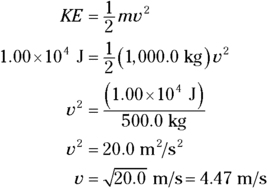


 m2/s2
m2/s2

 m2/s2
m2/s2















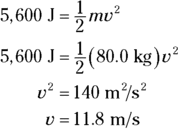






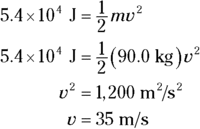

 is the angle between them. The gravitational force on an object is mg (mass times the acceleration due to gravity, 9.8 meters per second2), and when you lift the cannonball straight up,
is the angle between them. The gravitational force on an object is mg (mass times the acceleration due to gravity, 9.8 meters per second2), and when you lift the cannonball straight up,  , so
, so
 at some reference height) is
at some reference height) is









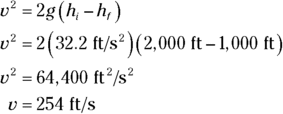





 and kinetic energy
and kinetic energy  , the total mechanical energy at Point 1 is
, the total mechanical energy at Point 1 is

 , or
, or
 .)
.)

 — allows you to solve for individual variables, such as velocity and height. You can use the principle of conservation of mechanical energy to find an object’s final speed. Check out the following examples.
— allows you to solve for individual variables, such as velocity and height. You can use the principle of conservation of mechanical energy to find an object’s final speed. Check out the following examples.




 is the initial velocity, g is the acceleration due to gravity near Earth’s surface, and
is the initial velocity, g is the acceleration due to gravity near Earth’s surface, and  is the final height (in this case, when the velocity equals 0).
is the final height (in this case, when the velocity equals 0). :
:
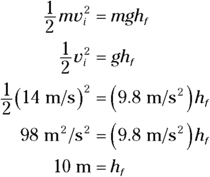

 meters. Plug in the values for v2 and h1:
meters. Plug in the values for v2 and h1:
